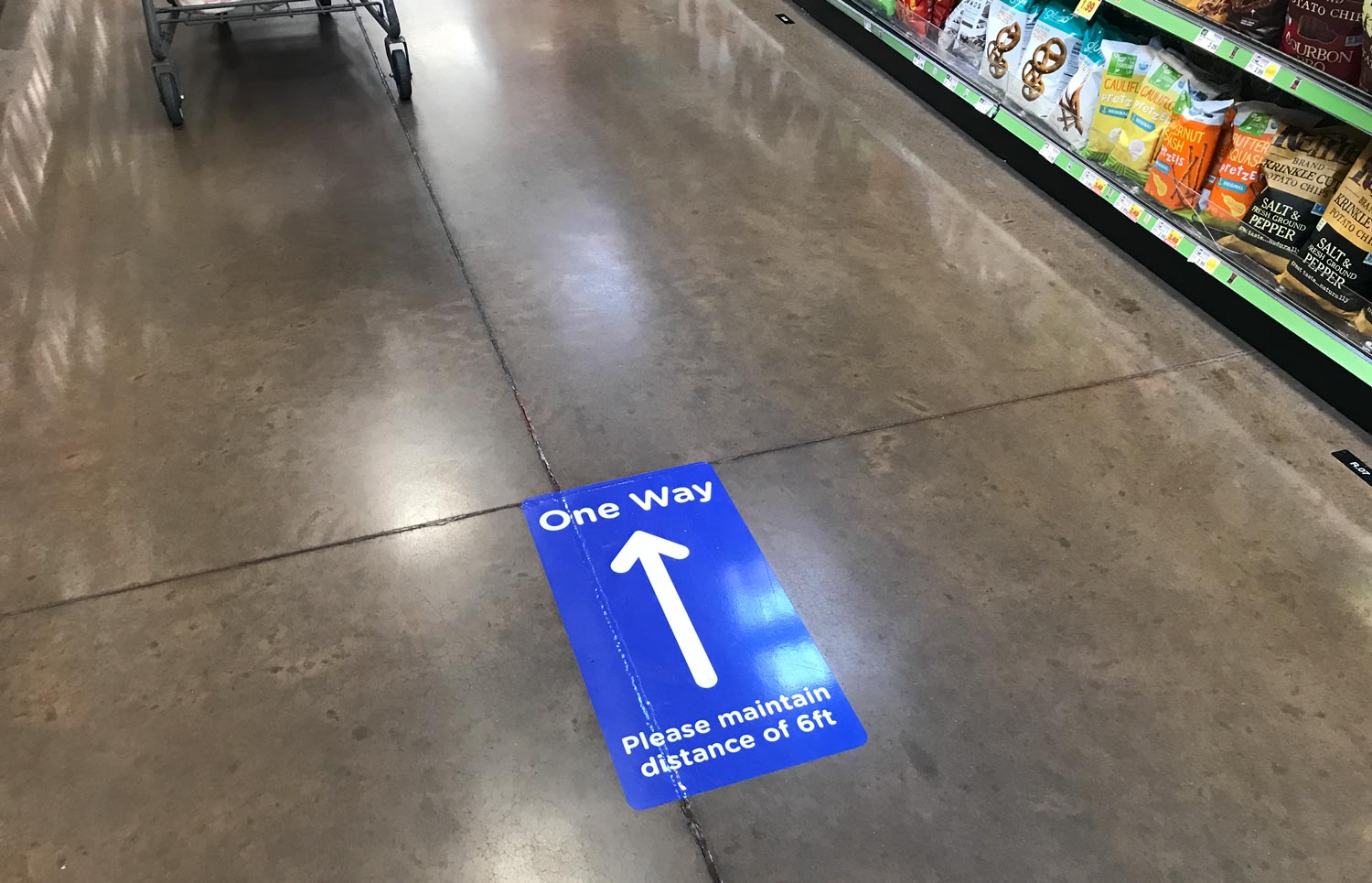What does the future hold?
Photos by Forrest Anderson and Tai Anderson
Predicting the future is a notoriously dubious pastime in the best of times. Doing so during an unprecedented and catastrophic global event may be bordering on lunacy. However, a lot of smart, well-informed experts in different fields are taking a crack at it and it turns out that there is a fair amount of consensus between them.
I culled through some 300 pages of predictions by several dozen business, economics, international relations and health care experts. Many of them believe that because the coronavirus is more of a natural disaster than a financial or political crisis, it will follow the trajectory of other natural disasters. That is that most fundamental problems and challenges will remain after the pandemic subsides. That means that long-standing trends will move further along the same direction that they were going before the crisis but will be accelerated by it.
These experts say that the pandemic has unleashed both huge dangers and huge opportunities. It is uncertain that our global system can survive them, as it already was threatened by climate change, religious extremism, a growing income gap, destabilizing waves of migrants, volatile markets and limits on basic resources such as clean water.
The coronavirus economic collapse has been compared to the Great Depression of the 1930s, when unemployment in the United States was 25 percent. The short-term damage from the pandemic is expected to be greater than the Depression with unemployment for this year as high as 30 percent.
Some believe that the economy will bounce back more quickly than it did in the Depression because it was robust before the crisis arose. The recovery depends on whether the virus subsides so that it no longer is a threat to personal safety. There is historical precedence for this view – the Spanish flu of 1918 was followed by the booming 1920s and some other pandemics have been followed with similar prosperity. However, some economists say the recovery will be more gradual and could take years.
Health
The prognosis
Coronavirus is currently the leading cause of death in the United States. Most experts are considerably less optimistic about early reopening than some government officials have been. The experts say that the need is for people to shelter at home for months and the virus will be among us for some time.
Exactly what that will look like will depend on medical advances that have not been developed yet and the extent to which we protect ourselves with social distancing.

Masked shoppers outside Costco, Spanish Fork, Utah.
Reopening will depend on a gradual approach, widespread testing and surveillance, medical advances and the eventual development of an effective vaccine.
There won’t be a return to normalcy this summer. The experts’ hope is to keep the lockdown in place until we get close to a minimum rate of deaths. At that point, restrictions can be lifted tentatively and experts can look at whether the death rate then goes up. If it does, people will have to return to lockdown. This cycle could repeat itself a number of times.
Opening up starts with people still wearing masks and keeping six feet apart, so commercial venues such as restaurants would have fewer customers at a time. Travel would still be minimal and international travelers would still have to be under quarantine for 14 days after arrival.
School openings are uncertain because although very few children have been hospitalized or died from the virus, they could transmit it to teachers, parents and grandparents who could die. When schools open, children may have to sit six feet apart from each other for a while to see how it goes.
When offices open, people will have to sit six feet apart. Those who spend most of the day on computers anyway may be safer working from home. People in factories and warehouses will wear masks and perhaps have plexiglass between them. Different jobs will have different safety conditions.
The restrictions will have to be widespread because the virus is in every state and in a number of counties in every state. There is nowhere that is immune.
The ultimate goal is to create a vaccine and vaccinate everyone possible so that the virus will die out or slow down for lack of hosts to infect. There are two challenges – development of the vaccine and producing it in huge amounts. The previous fastest vaccine to be developed, for mumps, took four years in the 1950s, but there is hope that current scientific resources will result in a faster vaccine for COVID-19. It still could be months or years before that is achieved, however. Production of hundreds of millions of vaccine doses will be a monumental task that follows the vaccine’s development.
Many have expressed hope that the virus will subside in hot weather, but experts say it is spreading in parts of the world such as India, Brazil and Australia which currently have hot weather.
A very small number of people who have become infected have become immune, but scientists don’t think the virus generally confers immunity. They have said that no one should count on having immunity once they have recovered from the virus or try to contract it with the hope that they will afterward be immune.
Telemedicine
The already growing business of on-line medical consultations is expected to continue to grow amid the pandemic and beyond, with accompanying health care savings.
Health safety
The pandemic will spark a more long-term awareness of sanitation and food safety in stores, restaurants, gyms, theaters and other public places.
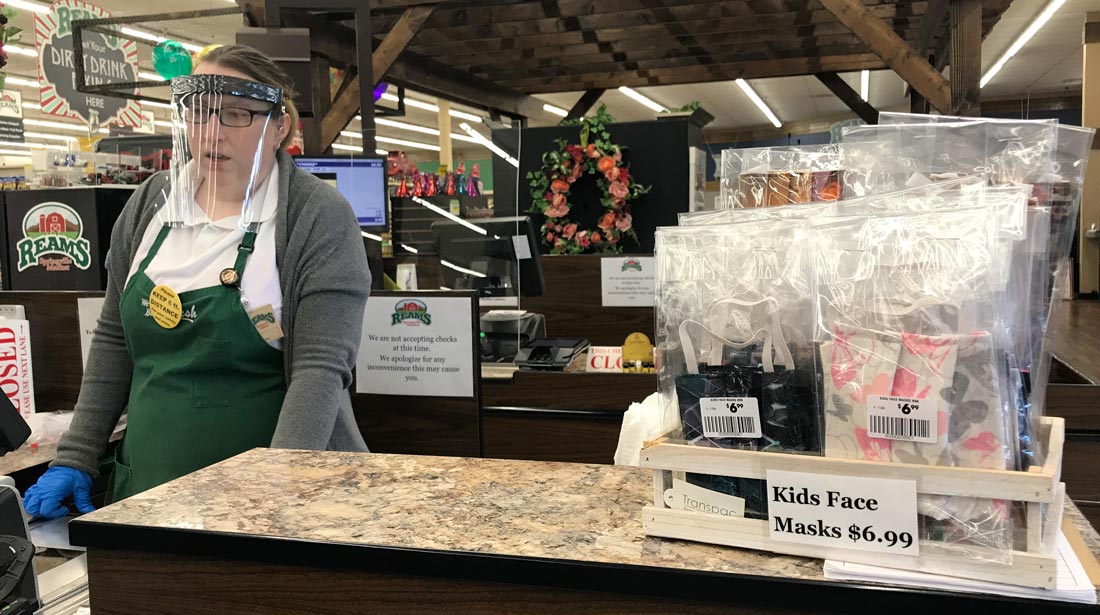
A scene at Ream's supermarket in Springville, Utah. The most successful companies will be those that manage to adapt so that they provide needed services and goods while protecting their employees from the virus.
High tech
The analog world is being decimated by the pandemic while the digital world is enabling people to weather it. This will make tech companies more dominant. As people have depended on technology in the crisis, criticism of large high tech firms has muted. Here are some areas in which the pandemic has thrust technology forward:
Virtual experiences
Not being able to gather at concerts, conferences, churches, sports events, museums and other venues has created a huge void in people’s lives that has opened up new space for virtual experiences. This has provided more opportunity to provide digital shopping, educational, e-sports, social, travel, cultural and even religious experiences. The challenge has been to create experiences that people want to spend time on and share as much as they would real-world experiences. Organizers and participants in events that have switched to digital have realized that there are pros and cons. Virtual events can have more attendance and go well, but they deny people the face-to-face networking opportunities of offline events.
Live streaming has merged with e-commerce so that people can shop and interact socially in real time online. This has allowed small players to host their own live streams to promote their products. People are going to on-line shopping environments not just to buy, but to hang out and chat.
Digital assistants are becoming more popular as people are seeking them out to educate and entertain them.
Many people have tapped into on-line education or mentoring as they have sheltered at home. This is expected to grow post-pandemic. People are learning languages via gaming streams such as Duolingo’s video gaming live stream platform Twitch. Children are taking on-line piano lessons. Companies with on-line platforms and communities are offering self-improvement opportunities.
Religion has been greatly impacted by the pandemic. The spread of the virus has been attributed to religious gatherings and pilgrimage sites in some countries. Many holy sites that have never previously been closed have been shut down. Important rituals that symbolize the key beliefs of religions have been disrupted. Once the outbreak is over, people will meet with greater prudence and there will be new rules on religious contact.

Many religions have temporarily closed down global missionary work and sent volunteers home while halting religious services worldwide or moving them to on-line formats. As a result, rituals and religious rites of passage have been put on hold.
Pandemic apps
National or global apps that can report and track people who have symptoms of the virus have risen to the fore. They use GPS data to track where exposed people have been and who they have interacted with. They can provide huge advantages in monitoring pandemics but many people are uneasy about their movements being tracked on these apps.
Robotics
The world’s reliance on technology is accelerating the development of innovations such as deliveries made by driverless vehicles and robotics and automation in factories to avoid workers getting infected.
Urban centers
Whether the crisis will empty out cities or help them grow long-term is uncertain. There has been a trend of people migrating away from cities in recent years, but past crises have tended to increase employment in the high-tech industry which is concentrated in urban centers. It is certain that the largest tech companies – Amazon, Facebook, Google, Microsoft, Apple, Netflix – will emerge stronger. However, some predict that cities won’t recover from the migration of urban dwellers to suburban or rural areas for social distancing. This will depend a great deal on Gen Z, which is urban and could help cities grow.
Broadband and related technologies
Adults with higher incomes enjoy broadband everywhere they go, an advantage that has intensified during social distancing. For millions of Americans, though, broadband subscription rates are prohibitive. During the lockdown, some students have not been able to access school online and adults haven’t been able to work online because of broadband problems. This may accelerate pressure to make broadband an essential utility, requiring a new approach to subscriptions and distribution. This is happening on a limited scale as internet service providers are offering services and wireless hotspots to school districts that have passed out devices to their students.
The virus is accelerating the need for hybrid or multi-cloud computing strategies. As part of pandemic plans, organizations will need to store their data and applications on multiple clouds so that if one cloud breaks down, they can access their resources on another one. The goal is to provide companies availability, continuity, scalability and disaster recovery. This will be an opportunity for technology infrastructure companies and cloud providers.
Because of COVID-19, smart cities, 5G wireless capabilities and real-time communication technologies will grow. Some of these technologies will probably be controversial. The government will be able to perform facial recognition scans in public places and determine based on body temperature who may have the virus. This will raise privacy issues and people will have to choose whether to make compromises in the interest of public health safety and economic prosperity. The pandemic may, like terrorism, induce people to accept less freedom and more government. These technologies could help mitigate future outbreaks as well as improve traffic control, create smart electric grids, and further automated driving.
Technical solutions such as VDI/streaming and SaaS apps that run somewhere else besides in the location where the end user is will grow. Such technology allows employees to be given a PC kit with a corporate application on it that they can run at home through a VPN or a VDI that gives them access to a virtual workspace. Streaming options such as Amazon AppStream or Workspace could work for employees who need to access only one app.
Supercomputing
Supercomputing and quantum technology – mining the world’s largest data sets to solve the largest problems – have been accelerated by the pandemic and will be used to hasten medical solutions, analyses and testing and vaccine trials. Major tech companies have formed consortiums to accelerate this research.
Cashless society
A fear of handling virus-infested bills is fueling growth in digital-based platforms such as Venmo and PayPal. More business owners are going cashless for greater efficiency, reduced wait times and to mitigate theft. Because people have become more aware of touchable surfaces transmitting coronavirus, payment options that allow consumers to pay on their own devices could avoid sanitation problems with public touch screens.
Social distancing
When the virus is controlled, people will return to connecting much more in person, but the growth curve of virtual activities is expected to be permanent. Part of the reason is that our pre-pandemic level of social engagement was greater than the historic norm and we may not return to all of our previous habits. For much of the world’s history, people have engaged in some level of social distancing because of the possibility of pandemics. People lived in less dense populations, observed more reserved social conventions, ate out and congregated much less in large gatherings before the 1950s, when the polio vaccine was developed. We since have become complacent about devastating pandemics as we have enjoyed the benefits of vaccines, modern medical care and modern sanitation, but the coronavirus has destroyed that collective sense of invincibility. Going forward, people will likely be more cautious.
The search for more sanitary environments is likely to remain after the virus and be designed into physical spaces to make staying healthy more effortless.
The pandemic has triggered a mental health crisis on top of already substantial pre-pandemic anxiety about politics, work, personal stresses and climate change. Some businesses and organizations are providing on-line mental health services to employees and universities are doing the same for students. The trend to offer a variety of ways for people to remain calm is expected to grow.
Improvements in basic life skills
In a crisis, more people tend to concentrate on home and family and to become more religious. Polls indicate that a third of Americans now want to stock up on non-perishables, focus on health and fitness, and 74 percent plan to continue habits such as frequent hand washing after the pandemic.
As more people have been at home, they are reviving or learning skills such as cooking, gardening, sewing, and other do-it-yourself skills. Many will drop out of these when the crisis is over, but others will continue to modify their lifestyles in this direction because they have enjoyed doing them, want to save money or want to be better prepared for the next global crisis. This is an opportunity for companies and organizations to help people become more prepared and independent.
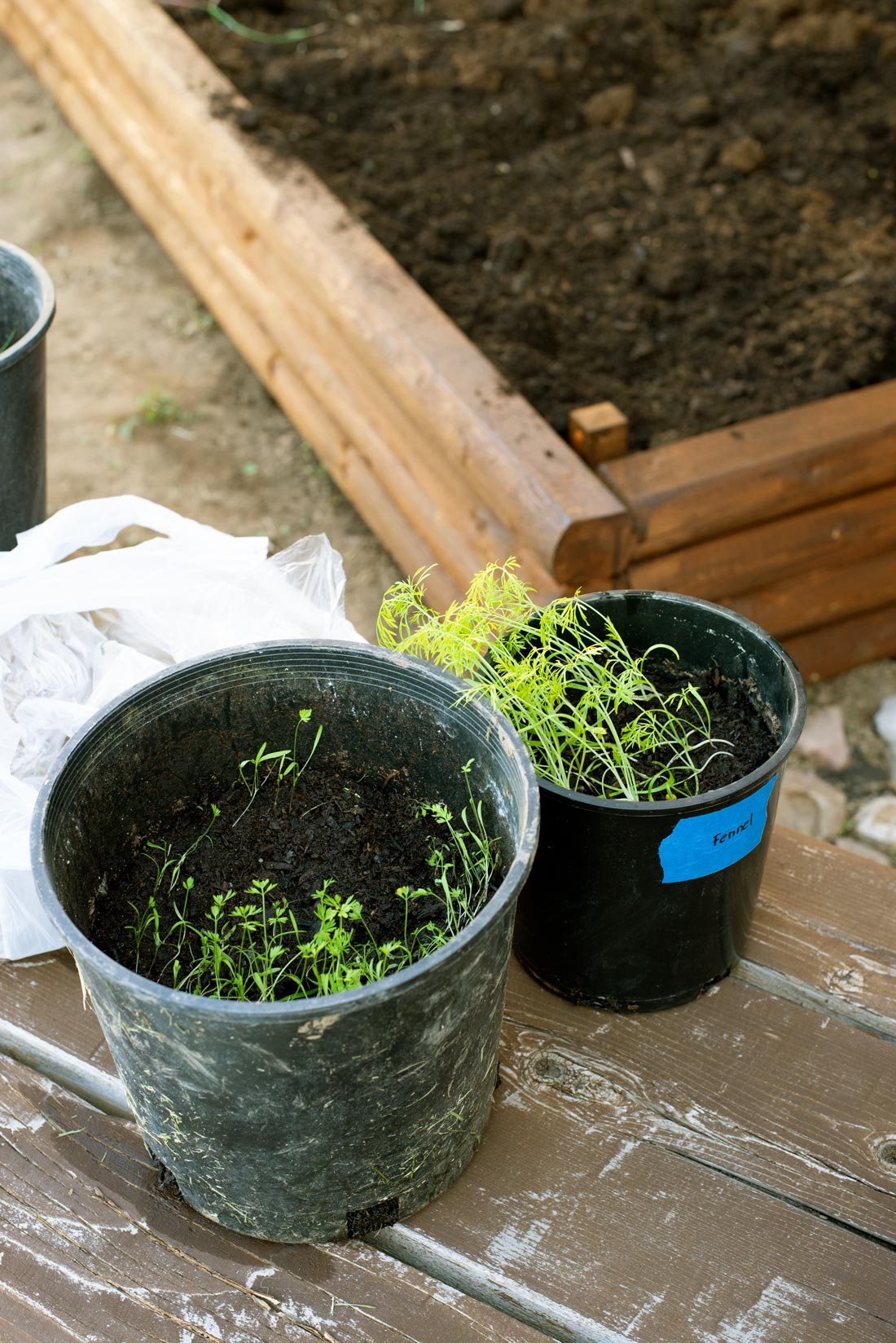
Gardening and DIY have boomed during the pandemic as people have sheltered at home. Stores such as Home Depot, have struggled to provide a safe environment from the many people seeking supplies for these home projects.
Housing problems
Another trend that has been thrown into sharp relief is high basic housing costs. The typical low-income renter family spent more than half of its income on rent before the pandemic. Now many of these people’s income has disappeared with mass layoffs. Governments have instituted temporary eviction halts, but unpaid rent debts have increased. The housing affordability crisis will be worsened by the pandemic in the short term and persist in the long term.
International relations and trade
Coronavirus is accelerating the process of sharing innovative solutions to the toughest problems that are shared between borders. In an ideal world, this would usher in greater international cooperation that could promote peace, prosperity and democracy as well as control over outbreaks. For this reason, some experts hope it will strengthen global cooperation.
Others are less optimistic, for valid reasons. Overall, there is little international consensus in today’s world. Some believe the pandemic will weaken globalization, undermine free trade and lead to regime changes in countries with shaky governments.
Part of the reason is that there is no longer a single international leader to rally other countries. Neither the United States nor China have the will to take on this role as the United States once did.
Some experts say the pandemic will bring about a new China-led world order, but others think it is helping to trigger a decline in Chinese influence internationally as many countries have become disillusioned with both Chinese and U.S. leadership. The pandemic has reinforced trends such as waning U.S. leadership, global conflicts and discord between the great powers.
As the United States hasn’t taken a leadership role in fighting the pandemic or its economic effects, other countries are looking to their own resources or China for solutions. This follows a trend that started with the last recession. The United States’ relative advantage over China has long been shrinking even as U.S. absolute economic and military strength has grown. The United States’ pulling back is not because it lacks the capacity to take a leadership role, but because the current administration shows little interest in strengthening alliances or maintaining America’s traditional role in major international issues.
The virus ironically will turn many Americans inward toward domestic issues even as it demonstrates how deeply Americans are affected by international concerns.
The slow federal response and the huge American death and infection toll from the coronavirus will likely exacerbate negative opinions of the United States abroad that already were fueled by U.S. political discord, gun violence, the 2008 global financial crisis and the U.S. opioid crisis.
The pandemic’s global spread and the lack of an effective international response to it has illuminated the broader trend of poor global governance and collaboration amid challenges that no single country or international organization can handle alone.
The main response to the pandemic has been on a national or regional basis, not an international one, and it is unlikely that international efforts will emerge to help the world recover. This doesn’t portend well for the next critical global problem – the climate crisis.
China and the United States have had increasing conflict for years and the coronavirus has sharpened that. Many in Washington blame the Chinese government for not locking down Wuhan more promptly, even as the United States was slow to lock down its own cities. Leaders not just in the United States but many other countries resent China’s subsequent efforts to tout itself as a successful model for handling the pandemic and to expand its influence globally during the pandemic. The chaotic U.S. response to the pandemic won’t change China’s negative views about the United States or reduce Chinese resentment in other areas of conflict such as trade, Taiwan, the South China Sea and human rights.
The pandemic has exacerbated American fears that the United States is becoming too dependent on China for essential goods and is too susceptible to Chinese intellectual property theft and spying. It is likely to cause both the government and American companies to pull away from China.
The pandemic is increasing resistance by many countries to accepting immigrants and refugees from developing countries, despite the fact that the largest outbreaks have been in developed countries. This is partly because unemployment is increasing in developed countries. The result will be a greater burden on developing countries. Border control during the pandemic also could increase fear of foreigners.
The coronavirus is ballooning an already mounting public and private debt problem amid demands for governments to cover health care costs and support the unemployed and faltering businesses. Governments are facing demands and requirements that they are not equipped to meet. There will be demands for governments to take a larger role, which could threaten civil liberties. Many people will use the virus as a justification to demand universal health care and health security will become a higher priority. Governments will stockpile protective gear and ventilators.
European integration was faltering before the coronavirus and the balance of power could continue to swing from the European Union to national capitals, as they have been the ones that have mostly dealt with the pandemic.
The pandemic is accelerating long-term shifts in global supply chains. Shortages of medical items such as masks and ventilators and of basic groceries such as flour have revealed weaknesses in the sourcing, distribution and storing of some supplies. The pandemic has sparked serious discussions about building safer and more reliable supply chains that will suffer minimal disruption the next time there is a global disaster.
Many multinational companies are making major changes in their supply chains, including diversifying manufacturing and delivery options away from one country. For many, this means China, which represents about 30 percent of global manufacturing. These companies are moving some operations to Vietnam, India or Mexico and manufacturing centers to Canada, Latin America, Malaysia or Indonesia. This despite higher labor costs, which some companies hope to mitigate with more automation in manufacturing. This trend was under way pre-pandemic as companies moved some operations out of China to avoid the U.S.-China trade war tariffs, but the pandemic has ramped it up.

Americans have benefited for years from inexpensive goods from China and other distant places. Some businesses are rethinking such long supply chains of diversifying them because of the pandemic.
China, meanwhile, has been redirecting its financial support toward higher value technology, a trend that the coronavirus shutdown there has speeded up.
More companies are creating regional domestic supply networks. The movement of the world’s goods is 80 percent dependent on trucking, and trucking costs have tripled during the pandemic. As a result, many companies are looking to ship more by rail and to warehouse goods in closer proximity to rail terminals. They also are switching to more diversified transportation and shipping to several ports.

Some businesses are questioning the dependence on trucking because the cost of trucking has tripled during the crisis. At the same time, clean energy sources such as solar and wind are getting a boost from the large number of people using energy while sheltering at home, while the demand and price of oil have dropped as people are driving less.
Walmart, for example, used to import everything from China to Los Angeles, but is now using four ports. Companies that are changing their sources of imports also will switch to using new ports, which will affect where they place distribution centers and their infrastructure.

Port containers from all over the world in Charleston, South Carolina.
Low inventory has been considered a good thing, but many companies are rethinking that as panic buying and surges in demand for basic supplies have overwhelmed supply chains. Some companies have decided to keep additional regional inventories of critical items on hand to satisfy demand in an emergency. Another force pushing regionalization is green consumers’ concern about the environmental impact of long transportation routes.
Regionalization will have both negative and positive effects. International trade relations can be a significant force for peace as they foster interdependence and cross-cultural cooperation and dialogue. As those relationships weaken, the likelihood of conflicts between countries may increase.
Many business models will be reimagined

Retail stores will have to be creative and nimble in reimagining and setting up ways to meet customers' changing needs as a result of the pandemic.
Before the crisis, retail outlets, their landlords and their suppliers were challenged by tariffs, a shift in consumer demand from products to experiences and away from shops to e-commerce, and the sharing economy, in which individuals share their assets and services free or for a fee via the Internet. The coronavirus has accelerated this trend dramatically with a sharp drop in retail sales.
Brick and mortar retail has tanked and will continue to decrease, with some retailers that have a strong on-line presence having primarily marquee locations for branding and customer service. Retailers will need to be very creative about launching new business models to survive the crisis. On the backend, retailers are experimenting with short-term leases and profit-sharing ones to help them survive slowdowns and give landlords an added return on their investment.
Spending on discretionary items such as entertainment, health care, education, clothing, cars, home appliance and electronics has stalled amid the pandemic. The fashion industry in particular has been devastated because clothing is a discretionary item and has a long global supply chain that has been hit at every point – lockdowns at manufacturing centers in Asia, transportation cost increases, and lockdowns of retail stores.
Far more shopping is being done online, including everyday goods and foods shipped directly to homes.

Michael's is among many stores that are moving more on-line and adding delivery pick-up for customers.
Consumers also are buying more goods closer to home, making local communities key areas for businesses to connect with consumers. Community supermarkets, convenience stores and pick-up points for merchandise purchased on-line are playing an increasing role in the delivery of goods during the pandemic, especially in areas most affected by it.
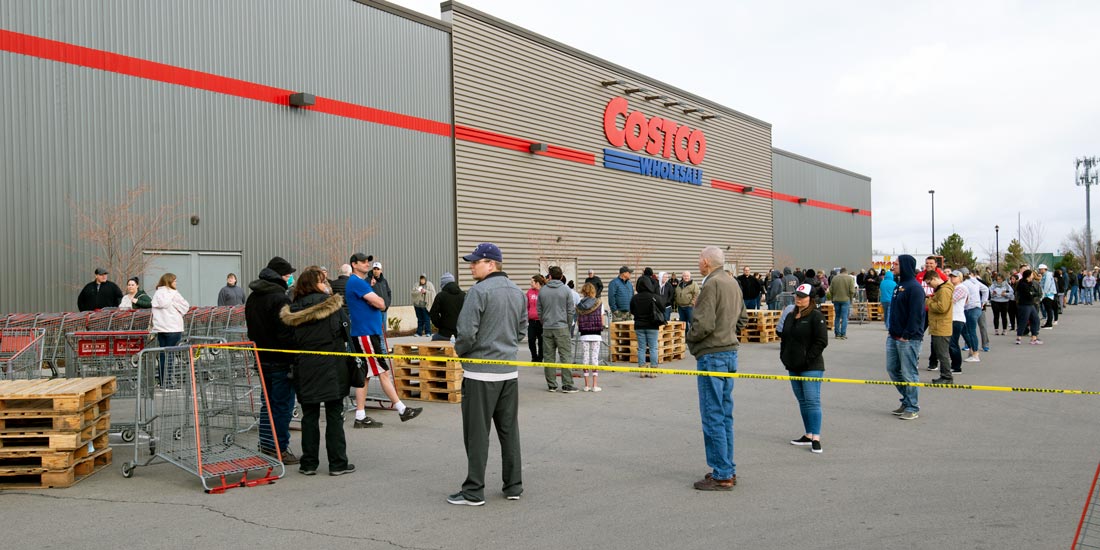
Costco was impacted hard and fast by the pandemic as consumers flocked to stock up on basic food and other necessities. The store has instituted social distancing changes, but keeping large numbers of customers away from each other and shelves stocked have been a major challenge.
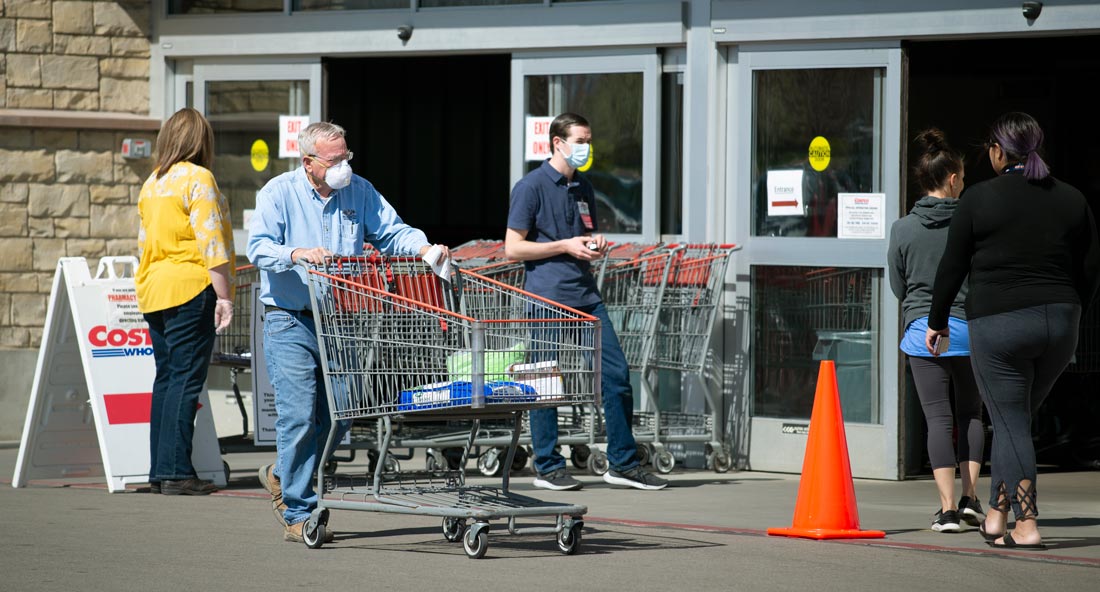
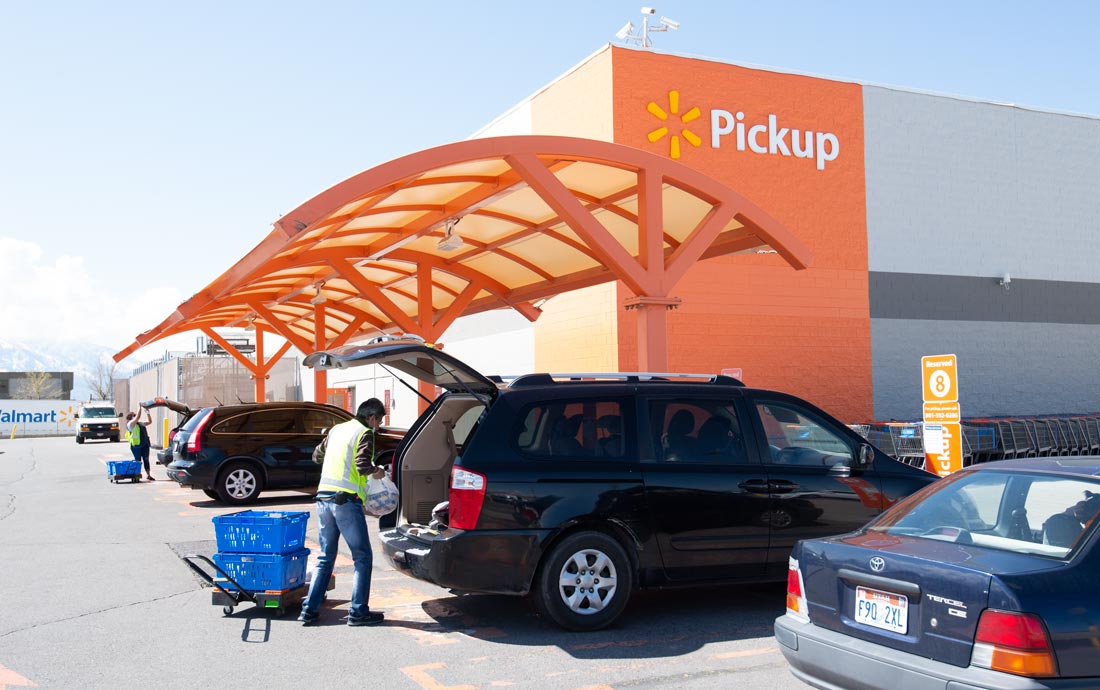
An employee loading items in a customer's car at a Walmart pick-up station.
Before the pandemic, the restaurant industry was oversaturated and even large chains were not growing much. The weaker players now are being demolished by the pandemic.
Before the pandemic, many restaurants were adding food trucks or drive-up windows, and that has vastly increased during the crisis as has app-based delivery and picking up prepared foods from wholesalers. In areas that have reopened in China, consumers have preferred to eat at restaurants in their own neighborhoods at least initially. This trend probably will be seen elsewhere as people continue to stay close to home for a while. Access to food retail close by also will continue to shape office and residential tenant demand and home sales.
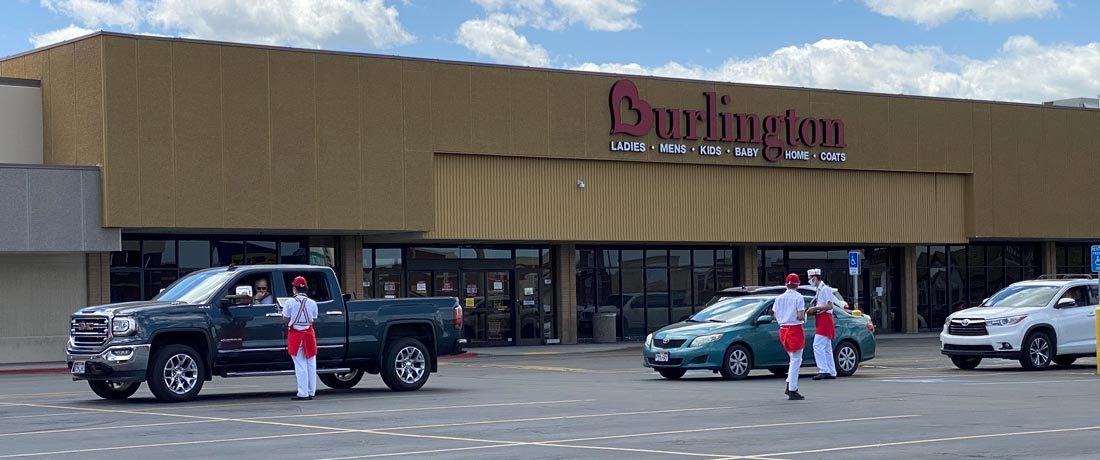
Employees taking orders from customers in an In 'n Out burger line. Going to a drive-by model has been a win for this company.
Before the coronavirus, only 57 percent of small businesses were profitable and a little less than 25 percent were losing money as profits were migrating from small businesses to large ones. These trends accelerated in the 2008-2009 recession and some 2.9 million microbusinesses are at even more risk from the coronavirus.
The travel and hospitality industries are expected to bounce back quickly when the pandemic has subsided, but hotels, airlines and cruise lines will have to be more health and sanitation conscious and take into consideration social distancing. Wiping down airplane seats with disinfectant will be common and face masks may be an inflight amenity. Airlines may block off middle seats, possibly for an added fee. Passengers may no longer stand in long lines at check-in, security, immigration and gates. They will be screened for illnesses, perhaps at self-service kiosks, and may have to carry cards showing their immunizations.
Cruise companies will have to provide better on-board medical facilities and testing and better ventilation and sanitation systems. Passengers will need to verify they are coronavirus-free before boarding and at various points in a cruise.
Offices
The coronavirus is forcing businesses to dramatically adjust the way they do business. Some of these efforts will likely carry forward after the pandemic.
Conferences, collaboration, sales and commercial real estate all are being rethought in a speeding up of a trend that has already been at play. Collaboration is relying more on video conferencing and less on travel. Many companies are saving a significant amount of money because their employees aren’t traveling as much. Initially, these savings will be eclipsed by the virus’s impact, but some of the new efficiencies will remain post-pandemic. Some businesses are questioning spending so much money on commercial real estate when their employees can work at home without productivity loss.
The percentage of Americans who work from home at least some of the time has been increasing and was near 50% before the pandemic. This will accelerate, shrinking corporate workspaces and resulting in conversion of some commercial real estate to residential buildings to meet the housing demand.
As there has been a surge in working from home and collaborating remotely, Zoom has become the most downloaded app. With this has come concerns about trolls jumping onto non-password protected Zoom calls and screensharing pornographic content. There have been other security concerns with Zoom, and other more secure formats also have seen a surge in usage.
We can expect more remote work in the future as well as companies creating pandemic plans to get their workforces working remotely if need be. By 2028, 73 percent of work teams are expected to have remote workers.
Studies have indicated that employees sheltering at home are practicing better time management skills, including keeping meetings to the amount of time needed to accomplish work goals.
More than 85 percent of workers in one survey by Thrive Global said they needed more help from their employers in adapting to working from home. About half said they experienced loneliness and anxiety, but it is unclear how much of that is fear of the pandemic or economic upheaval rather than remote work itself.
The pandemic’s challenges are likely to weed out less competent leaders in all fields and force other leaders to step up to the plate. Leaders are more likely to manage based on outcomes and goals rather than employees’ presence. Many companies have had to delegate decision making to employees to respond quickly to customers’ and the companies’ needs. The challenges of working in the crisis is forcing new ways of thinking and solving problems. People working from home may reveal new capabilities, ways to contribute, policies and approaches.
When employees return to the office, employers will be forced to consider enhanced cleaning techniques, more distancing and increased flexibility for employees on where they work and when it works best.
Remote work is likely make employees more adept at technology who will leverage it in new ways. Companies will be more likely to upgrade their infrastructures. Bureaucracy will decrease and speed will increase. Many companies have streamlined their processes during the lockdown. The coronavirus is likely to lead to more efficient operations, practices and higher profits in some sectors, effects that may remain permanently.
The pandemic is forcing companies to reassess critical jobs and definitions of responsibilities and key tasks. This will provide new career opportunities for people who can ramp up quickly when the economy recovers. When the coronavirus abates, there will be a potential deluge of new businesses that use ingenuity and speed to solve problems. This will create new jobs.
The move toward remote work is accelerating changes in the labor market toward more project-based work, because as the employer/employee relationship moves to remote work it is similar to outsourced contractual services. These have substantial tax benefits for employers.
Some competitors are collaborating with each other to find jobs for displaced workers, manufacture critical medical supplies or negotiate the more challenging business environment. More and more consumers are becoming comfortable with taking care of their needs and working digitally.
More people working from home means less wear on roads and less traffic. If this continues on some level, it will reduce the maintenance load for local governments, the demand for fuel and vehicle pollution. It will save workers money because owning and operating a vehicle can cost up to $10,000 annually in payments, gas, tolls, insurance and maintenance. That doesn’t include commute time.
The surge in screen time has increased the demand for intermittent electricity such as solar and wind power while there has been a 30 percent drop in oil consumption. On the other hand, low gas prices plus the downturn could deter people from switching to electric vehicles. Migrating to clean energy systems in a recession in which there is cheap oil may not be attractive to some. The pandemic also has been a distraction from climate change.
Education

A student at Brigham Young University in Provo, Utah. Universities have been hard hit by the pandemic.
On-line learning has been vastly accelerated as schools at all levels have shut down globally. The result has been mixed. On-line learning had already been growing at the college level and teachers at all levels were using the Internet extensively. Whether the trend will be long-term is debatable, as many teachers and parents have not been impressed by the switch to on-line learning. It is likely that more successful vestiges of it will survive while students head back to school. Maintaining school facilities is very expensive, but teachers have complained about many students not showing up on-line to complete schoolwork.
Many believe that online higher education can never match on-campus education, as meeting people, interacting with peers, students and supervisors is key to a deep understanding of topics. Practical application in laboratory-based classes in medicine and science has been postponed until campuses reopen. Lecturers have reported heavier workloads as they are adjusting to online lecturing. It is harder to do group activities for student assignments. Some have said that students tend to ask fewer questions online, but that shy students who are uncomfortable speaking up in class have been more willing to make comments in writing in on-line classes.
Some universities are offering not just teaching, but online counseling, thesis supervision and other on-line support services.
Some students and teachers say they like online courses and the flexibility of them is important to them. After the crisis ends, online lectures will still be valuable because more people can view them. However, education experts think they won’t make teachers obsolete because online lectures alone don’t provide a complete education. Educators provide tutoring, personalized feedback, mentoring and meetings in which students also learn from peers. Mentors have a major impact on students’ life choices and career success.
On the elementary, middle and high school level, many teachers are finding that technology can provide information and processes for students to interact with their curriculum, but they also need constant interaction with adults and other children to learn.
The pandemic has exacerbated long-standing problems of the cost of attending college growing much faster than inflation. The price of attending a university has more than doubled in inflation-adjusted dollars in the past 40 years. Universities and colleges have upgraded facilities and provided increasing amenities, going in debt to do so, to attract students as enrollments have fallen.
When students spend $50,000 a year to attend a school, they’re paying for the entire college experience. When education is online, the social life and extracurricular activities are gone. That isn’t worth paying full tuition for.
Many parents of college students are experiencing job and other financial losses amid the pandemic. They may choose to hold off on pricey colleges and send students to local ones. This will leave colleges and universities in a serious financial bind. If they let employees go, they weaken institutions which they have built up over decades.
Some colleges probably will disappear, some will become branches of state systems and some will be absorbed by rival institutions.
Modern economies, the point of which is to produce more, has not responded well to limiting people’s production through lockdowns. This has prompted some experts to question whether the economy needs to be rethought, because producing less also is a useful strategy for tackling climate change. Some essential services are hard to make more productive, such as health care, so its costs are going up. The pandemic has shown that some essential jobs are not rewarded highly and people are often forced out of them as a result. These will be fundamental questions that will be asked as the pandemic plays out.
Check out these related items
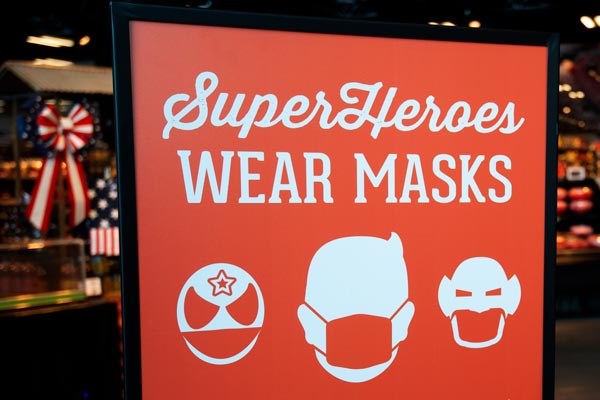
Selling Happiness and Security
As businesses are scrambling to adjust to a challenging economic environment, some are thriving or recovering. Here are reasons why.
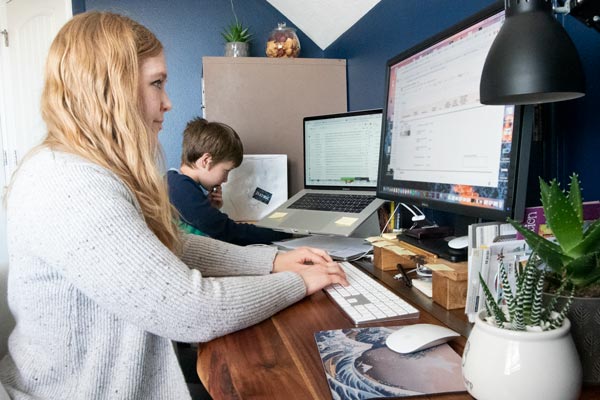
Let’s Get to Work - From Home
Remote work is one of the best ways to limit the coronavirus and keep the economy going. Here's a guide to how to work from home.
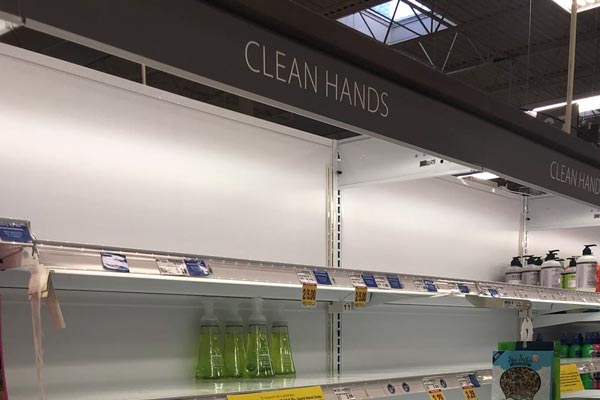
Signs of the Times in Stores
During the pandemic, here are signs of the times at stores with shortages that also are trying to maintain social distancing.

Small Business Meets Fortune 500
This case study on business design highlights a small business that provides tax director services for Fortune 500 businesses.

Great Global Pandemic Bake Off
Where have all the flours gone? A home baking surge has sparked a flour and yeast shortage as mills scramble to reroute supply lines.
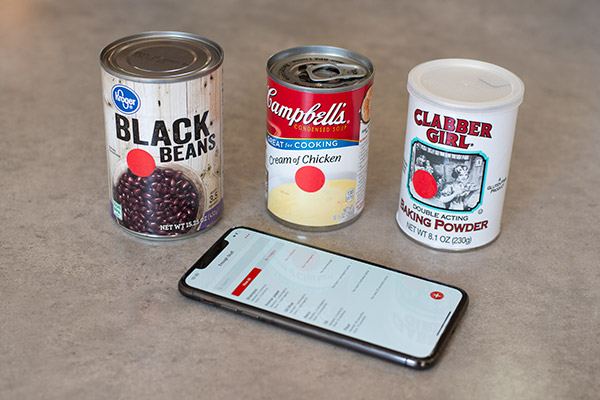
Inventory App and Sticker Dots
Use sticker dots and an easy inventory app, Enough Stuff, to keep track of your food supplies, toiletries and other stuff of all kinds.
